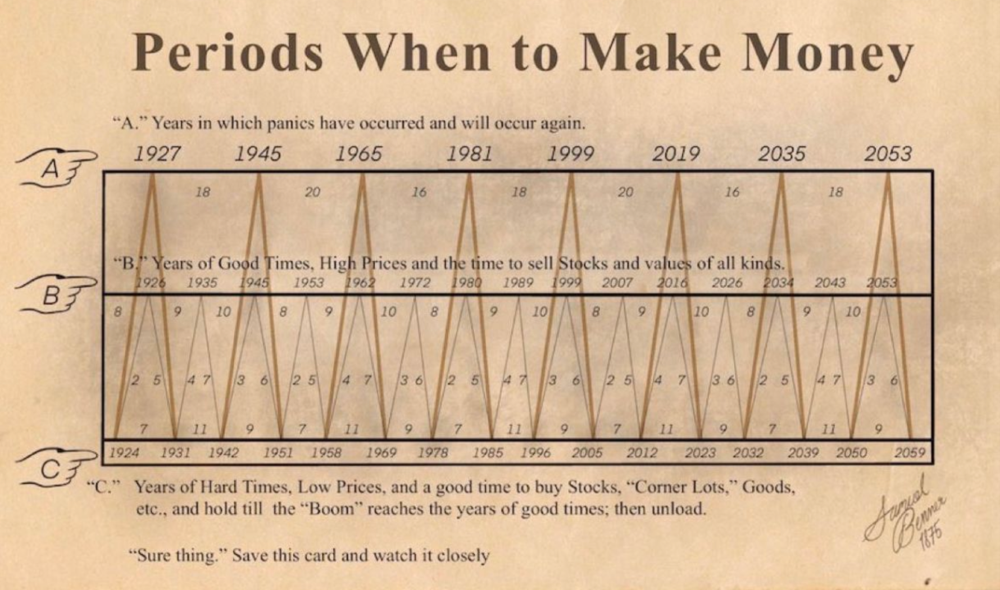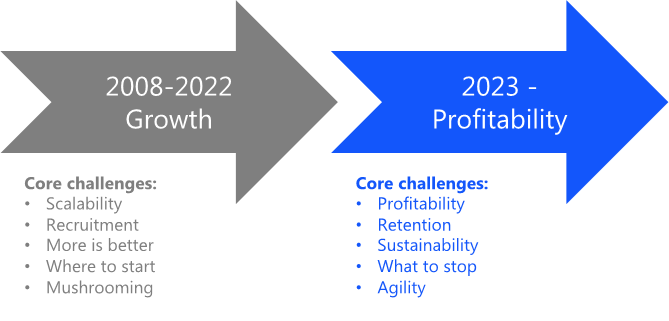Massive digital business leadership challenge ahead: Profit before Growth




In recent, booming years, all focus has been on Growth. But now we see and believe that we are in for a seismic shift in focus towards Profit. Profits before Growth will provide significant challenges particularly for leadership.
But before jumping into the specifics, let’s just conclude two things: Change is Constant, and the world has seen this situation before.
Recently, this fantastic and inspiring article from farmer Samuel Benner from 1875 has surfaced on various social media platforms. As Samuel Benner very clearly pointed out over 100 years ago: Market cycles vary precisely. And honestly, he gets it spot on (see figure).

The conclusions and academic validity of his projections can always be challenged – but that is not the point.
Let’s instead start with one big conclusion: Now is not the first time that focus has turned to Profit before Growth.
The shift towards Profits will impact everyone operating a business, be it B2B or B2C. Most businesses have already been impacted somewhat. It’s likely, however, that they’ve only seen the tip of the iceberg if this shift continues for years to come, which we expect. The most cyclical industries have been used to these changes over time. But companies that are based on online business models have never been through it before.
We love commerce, particularly e-commerce, and here the shift towards profits is new and for many e-commerce and omni-channel players it will be seismic. Since the birth of e-commerce, growth has been the imperative, and as we previously have discussed in the article Competitive Battlezones, competition in the e-commerce landscape has matured in 3 major phases:
For many years, e-commercers were growing and successful just by being available online, having competitive pricing, a broad assortment, and good delivery and fulfillment options. Many shaped their core business on this – and particularly pure-players before the original offline retailers finally woke up. These are of course still competitive parameters, but now they are, however, more seen as competitive hygiene factors.
Then in the mid 2010’s, the best e-commercers realized that more was required and began to compete on external visibility and omni-channel initiatives. This meant that competition transitioned into a battlezone where success was defined by the e-commercer’s ability to be visible on Google, Amazon, SoMe, and all the places where consumers were. Basically, a successful e-commercer was growing through ROAS and more channels – sometimes entering new geographical markets.
In recent years we have seen the best e-commercers focus on even more advanced competitive battlezones such as great customer experiences, customer lifetime value focus, business process optimization, and sustainability.
…This is where we believe the big seismic shift comes into play.
With this advanced competitive view, the most successful players know exactly where profits come from and how to improve the ease of doing business to retain their customers. And only the best ones really understand the role of sustainability and how to apply this to their marketing without green washing. An interesting example of mastering sustainability as a competitive battlezone is Patagonia.
What are we really saying here? Well, the seismic shift is actually very simple – let’s expand a little further.

There are mainly 5 parameters describing the shift.
For years, companies have been searching for massive scalability in order to grow faster. But now all companies need to look for profitability through focus on core processes and costs. This goes deeper than just applying a “scalability for growth mindset”. It requires a lean mindset to find those last 5 cents. A mindset that has previously been postponed or neglected in the quest for growth. This is a tough challenge, and for many not as “fun” as finding growth scalability.
It’s probably clear to anyone that it’s cheaper and simpler to retain a customer, than to acquire a new one. But the devil is in the detail. In recent years customer acquisition cost has increased significantly, and with a profitability perspective the alternative cost in losing a customer increases even further, adding to the urgency of retaining your customers before acquiring new ones. To be honest, loyalty has traditionally not been an aspect that has kept many e-commercers awake. Another aspect here is to retain the profitable customers. The authors of this article have both worked in retail, and knowing the profitable customers and their customer lifetime value is a rare insight that only few e-commercers really know with sufficient precision to act upon. However, retention and loyalty will be even more important in the future.
You might think; “Wow, what a headline, but it’s not true”. But please, hear us out. Since the birth of the internet and multichannel we have been in constant growth. More content, more and better media (high quality pictures and videos), more touchpoints, and more data. Basically, growth initiatives all over, and the “omni hype” has required everything to be connected on top.
The imperative of being consumer centric and justify the existence of a shop footprint also necessitated being present wherever the customers are. However, many consumers are not actually “everywhere” and the omni “hype” also has a flipside – it has increased the amount of data we are sending around and created huge complexity in most organizations. Many omnichannel players haven't really evaluated whether it is really profitable and sustainable for the environment and business to be “all over the place” and to chase last mile delivery at all costs. Less rather than more presence must be better for sustainability and profitability.
Typically, the biggest problem for companies was that they didn't know where to start, which led to almost endless digital initiatives and transformations. And guess what? Several studies show that most of them fail. But in a profit perspective this will change significantly as the new paradigm will focus on what to stop.
More is NOT better, less is. A lot of the marginal initiatives introduced only has limited or no impact. Especially if they are not a prioritized high risk innovation effort by the company, in which case they need to be skipped now. For years we’ve learned that more data, channels, media etc. is better for your conversion of the customer. But as mentioned above less can be very sustainable – also for profitability.
Often, companies have mushroomed when it comes to their business models and tech landscape, because it all created growth. However, mushrooming your tech stack with several integrations and custom logic have pushed many companies to be stuck with legacy. But in highly volatile environments as we are entering now, agility is now more than ever the key for success. This eventually means that companies need to clean up their business models and tech stacks to remove the “mushrooms”. With this move they can become more agile in their adoption to market changes. It's difficult, though, as many processes and routines need to be demolished – but it must be acted upon.
Yes, this is a comprehensive list of things to address. But we are only now getting to the biggest challenge of them all. The Leadership challenge.
If you can agree to the shift ahead, then the next challenge is even bigger. First of all, the digital natives (Gen Z or what they like to be called) have never tried anything else than Growth. It will be difficult for this generation to retain, motivate, and learn new and less fun elements of the cycle. Secondly, a culture built around the growth paradigm has been established in digital organizations and functions. Functions that have now developed from “hobby departments and ventures” to become significant parts of how companies operate. And as we all know, culture is more than sticky. Both these changes call for a major turnaround in leadership.
So let us hone in on the 4 core leadership challenges that needs to be addressed and discussed across business industries: Lean leadership, Motivational leadership, Predatory leadership, and not least Sustainable leadership.
As we've alluded to a couple of times, profitability needs to be analyzed and carved out through persistent focus on details and processes in most e-commerce business. This is tough and requires a high level of endurance and focus. We are not saying, the new generation cannot do this. On the contrary. But is must be learned – and it is tough learning. This goes for everyone stuck in the growth paradigm.
In years with growth everyone can accept certain levels of sloppiness in execution, analysis, and implementation. But in years with profitability focus and small margins, this is not the case. We need mature leadership who have either tried massive crisis before or can excel in driving lean projects to steer organizations and next generation to these skills and to profitability. The lean leadership requires high persistence, endurance, and focus, and many who only have tried Growth or just hopes that this profitability-thing passes by, will find this extremely demotivating and not what they signed up for.
This leadership characteristic needs to be in place at all times – not only now. But our point here is that motivational leadership is more important than ever and needs to be dealt with differently now. In the past 20 years with social media, we have focused on values that puts the individual at the center of everything. The next generation are good at understanding their limits and they are eager to show success.
In years of Growth there is a shortage of workers, and therefore many companies have thrown lots of benefits and flexibility on the table to attract talents, which has been fantastic for everyone. But in years with hunt for profitability, layoff rounds and decreasing workforce benefits will come into focus. Things that the new generation has not tried before. It’s not that we think the next generation is spoiled. We are simply saying that retention will be focused on top talents and employees that truly deliver – the rest will feel they are losing out on benefits and privileges. This can be perceived as a massive blow for them, and we hear more and more leaders talking about their employees saying that “it’s not fun anymore”. They want back to the growth days.
This will be a massive leadership challenge, and something that leaders need to address. In years of zero growth and focus on profitability, clear communication and high motivation will be more needed in the e-commerce industry than ever.
Ok, it is a tough headline. But what else to call it? In years of growth, the market “pie” has been expanding naturally. Organizations and their employees have been used to sales that were coming if just marketing and product did their job well. But what if excellent product and marketing doesn't generate the same leads anymore? What if sales and leads need to be hunted down by hungry predators? Or what if you need to steal part of the pie from someone else to survive?
This situation simply requires a completely different skillset. Successful salespeople will be the ones that have tried these skills before or the ones who can learn it fast. In a market where many is fighting to survive, you need to learn how to fight. We acknowledge that the new generation can fight and survive, but most of the next generation hasn't really tried the predatory approach. Again, leadership needs to unleash the predators and go way more offensively to the declining markets. This requires balanced and systematic leadership and a steady hand in the back pushing for urgency.
We are inspired by a former Danish national Icehockey coach who once said that the Danish players needed more SOUL, in Danish “Stolthed Over Udført Lortearbejde” (loosely translated into taking pride in doing the less glamorous work.) We can totally relate to this as part of the predatory leadership where cold canvas and fighting for the last cent may not seem like glamorous work – yet in times of hunting for sales and profit it's hugely important.
Sustainable leadership is the constant balance between pushing for a better future for the world, and at the same time delivering results that ensure a solid business today. This is perhaps slightly new in leadership, yet extremely important. It's probably the most difficult to succeed with, as doing the right things in tough times is hard and requires character.
Sustainable leadership requires leaders to balance making shareholders happy and deliver on the promises to the next generation – something that is often neglected in the hunt for profit and survival. Sustainable leadership will also need to understand the value of diversity, stress symptoms, and individual acknowledgement – while at the same time installing a team fighting spirit. Sustainable leadership requires so much more from leaders than ever before.
How we solve these challenges will be a massive undertaking, and there is no silver bullet or easy way for leadership. Now more than ever, leaders in e-commerce and in any industry needs ‘to get on the floor’ and get close to the action.
As we started out saying, “everything is just a cycle”. And yes. These leadership challenges have been seen, needed, and tried before. The reason we highlight them now is the fact that the e-commerce and digital industry is still maturing and is still young. They haven't seen it before.
Furthermore, the industry is populated with a new generation who hasn’t experienced these leadership challenges but been accustomed to growing business. They have been used to saying hallo to new colleagues every month – NOT saying goodbye through layoff rounds and pursuing small, but profitable margins. There is a huge obligation for those who've tried and survived these challenges before to help the e-commercers and digital natives to steer the troubled waters.
Do we have all the answers? No. But we know we need to talk about the leadership complexity that is increasing in the times of the seismic shift.
Carsten Pingel has been working within digital strategy and business development for the last 15 years. Former experience includes acquiring and scaling high-growth, multi-brand e-commerce businesses, and enabling digital transformation in the largest Nordic media group, Egmont, business development and strategy at Copenhagen Airports, and board positions in high growth e-commerce and SAAS companies. Now Carsten is leading the strategy consulting unit within Valtech, helping companies in their digital transformation, and utilizing data to accelerate growth.
Toke Lund has been working within management consulting, heading up the strategy office and the consumer insights office at the LEGO Group, driving digital transformation at Salling Group, and working as a digital strategy consultant at Novicell. Now Toke has founded Enterspeed, a software company delivering a high-performance product called Speed layer, which can accelerate digital transformation and composable setups.
Together, they've also written the article Surviving the Ecommerce Industry – Porter style.
(Header photo by Roger Bradshaw on Unsplash)

CEO and Partner at Enterspeed. Speaker on digital transformation and the future of Enterprise tech. Loyal lover of Liverpool! ⚽❤️
© 2020 - 2025 Enterspeed A/S. All rights reserved.
Made with ❤️ and ☕ in Denmark.